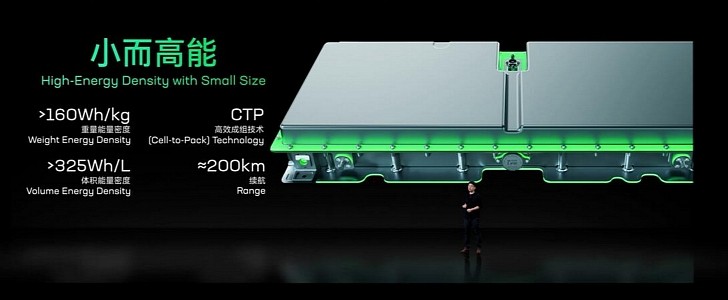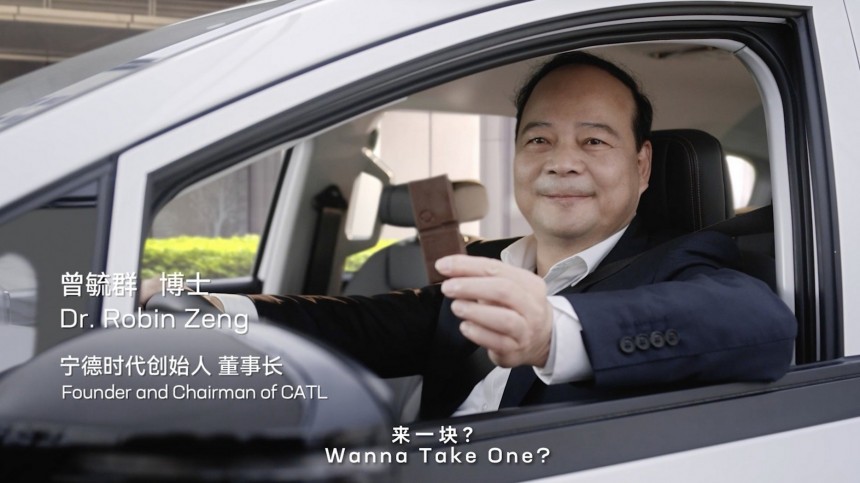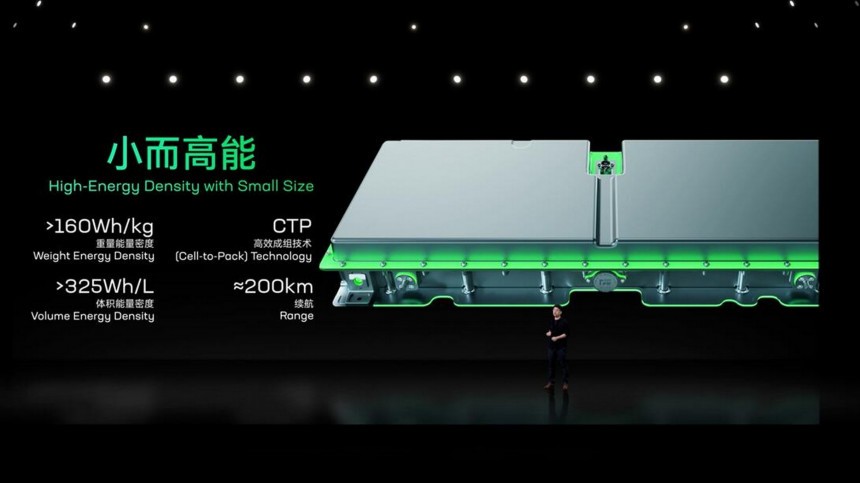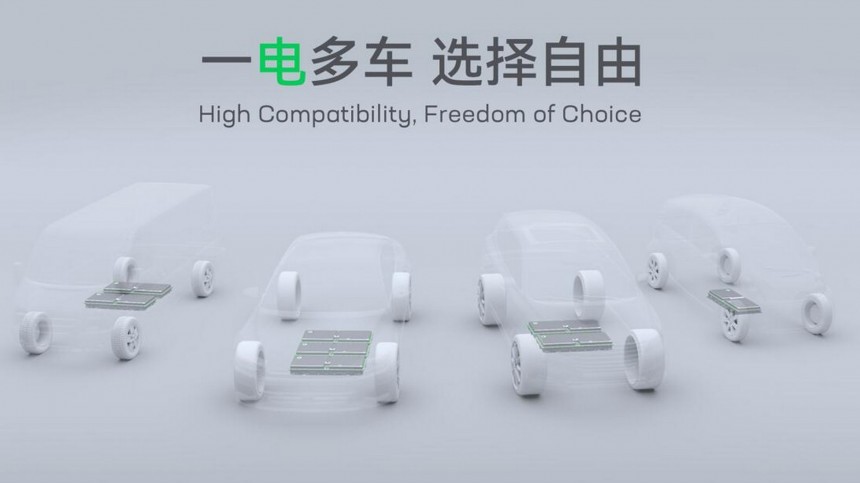One of the main discussions around battery swapping is that all automakers would have to come up with a standard so that they could work with any vehicle. Ample has proposed it in March 2021, but a much bigger company is now pursuing the same goal: CATL.
The Chinese battery maker is also the world’s largest cell manufacturer, which gives it a massive headstart compared to Ample. If CATL’s method is adopted by many Chinese automakers, it will provide it with the scale that may persuade foreign car companies to follow them as well. It even created a special business division for that: CAES (Contemporary Amperex Energy Service Technology). CATL stands for Contemporary Amperex Technology Co. Ltd.
Customers will know this new proposition as EVOGO. It consists of modular and swappable battery packs called Choco-SEBs (swapping electric block). Choco refers to chocolate since the modules resemble a bar of this sweet. It is not clear if the best design solution made it look like a chocolate bar and smart marketing guys used that as something to create more empathy for the solution or if it was designed as such on purpose.
Each Choco-SEB offers a capacity of 26.5 kWh, enough for 200 kilometers (124.3 miles) of range. They also have an energy density above 160 Wh/kg and a volume energy density of 325 Wh/L. With a wireless BMS system, the modules have only the high-voltage positive and negative terminals as exterior parts. CATL thinks that will make them more robust.
The Chinese cell manufacturer does not clearly state it, but the energy density and the fact that the swappable battery modules use CTP (cell-to-pack) to increase it confirm that these battery packs are made with LFP cells.
That’s an intelligent choice. LFP is cheaper and more resistant than ternary cells. They also prefer full charges, while ternary cells can only be charged to 100% eventually – for road trips, for example.
CATL said these modules are compatible with 80% of electric cars currently sold worldwide. The secret to making them fit multiple vehicles with different battery pack sizes is to use a different number of modules for each of them. A car currently using a 50-kWh battery pack could get two Choco-SEBs; one with a 75-kWh component would use three. Curiously, that’s the limit the new battery-swapping company established.
CAES has an interesting use proposition for the Choco-SEBs. One module will be enough for daily use. It will also make EVs a lot lighter, which may allow them to travel further with a single Choco-SEB.
If people need to make road trips or have more lengthy daily transportation demands, they can rent two or three battery pack modules. In other words, EV owners with this system would only use the number of modules that they genuinely need.
That will have an impact not only on the range but also on ownership and running costs. An EV owner would spend a lot less on their cars if they could buy them without the batteries, as NIO already does with its BaaS (battery as a service). By making EVs more affordable, automakers would no longer have to worry about possible lower production scales. Another advantage is that people would have a more similar experience to that offered by ICE cars.
Think about it: most people do not have to worry about the range of their combustion-engined vehicles. As long as it has a fuel tank, they are good to go. They do not have to spend more money calculating how much range they may eventually need if they decide to make a road trip.
EVs offer different battery pack capacities, and customers think they have to provide a minimum range, such as 300 miles. The larger it is, the more expensive the car, even if it will need fewer lengthy charging stops. Each Choco-SEBs takes one minute to be replaced. All three would mean people would spend less time on an EVOGO station than they do in fuel stations.
The Chinese battery maker plans to offer EVOGO stations in ten Chinese cities to get started. Each of them will have 48 Choco-SEBs. Considering that they will get discharged Choco-SEBs in exchange for the fully charged ones, the number of vehicles they will be able to serve each day will depend on the charging speed for these battery pack modules.
If you are concerned about which car will use these stations, that’s something CATL has already solved. The Bestune NAT – an electric taxicab made by FAW – will be the first one to benefit from the idea, but CATL promised it would announce the other vehicles that will also adopt it. For the sake of Choco-SEBs and the EVOGO network, they will have to be many.
Customers will know this new proposition as EVOGO. It consists of modular and swappable battery packs called Choco-SEBs (swapping electric block). Choco refers to chocolate since the modules resemble a bar of this sweet. It is not clear if the best design solution made it look like a chocolate bar and smart marketing guys used that as something to create more empathy for the solution or if it was designed as such on purpose.
Each Choco-SEB offers a capacity of 26.5 kWh, enough for 200 kilometers (124.3 miles) of range. They also have an energy density above 160 Wh/kg and a volume energy density of 325 Wh/L. With a wireless BMS system, the modules have only the high-voltage positive and negative terminals as exterior parts. CATL thinks that will make them more robust.
That’s an intelligent choice. LFP is cheaper and more resistant than ternary cells. They also prefer full charges, while ternary cells can only be charged to 100% eventually – for road trips, for example.
CATL said these modules are compatible with 80% of electric cars currently sold worldwide. The secret to making them fit multiple vehicles with different battery pack sizes is to use a different number of modules for each of them. A car currently using a 50-kWh battery pack could get two Choco-SEBs; one with a 75-kWh component would use three. Curiously, that’s the limit the new battery-swapping company established.
If people need to make road trips or have more lengthy daily transportation demands, they can rent two or three battery pack modules. In other words, EV owners with this system would only use the number of modules that they genuinely need.
That will have an impact not only on the range but also on ownership and running costs. An EV owner would spend a lot less on their cars if they could buy them without the batteries, as NIO already does with its BaaS (battery as a service). By making EVs more affordable, automakers would no longer have to worry about possible lower production scales. Another advantage is that people would have a more similar experience to that offered by ICE cars.
EVs offer different battery pack capacities, and customers think they have to provide a minimum range, such as 300 miles. The larger it is, the more expensive the car, even if it will need fewer lengthy charging stops. Each Choco-SEBs takes one minute to be replaced. All three would mean people would spend less time on an EVOGO station than they do in fuel stations.
The Chinese battery maker plans to offer EVOGO stations in ten Chinese cities to get started. Each of them will have 48 Choco-SEBs. Considering that they will get discharged Choco-SEBs in exchange for the fully charged ones, the number of vehicles they will be able to serve each day will depend on the charging speed for these battery pack modules.
If you are concerned about which car will use these stations, that’s something CATL has already solved. The Bestune NAT – an electric taxicab made by FAW – will be the first one to benefit from the idea, but CATL promised it would announce the other vehicles that will also adopt it. For the sake of Choco-SEBs and the EVOGO network, they will have to be many.










